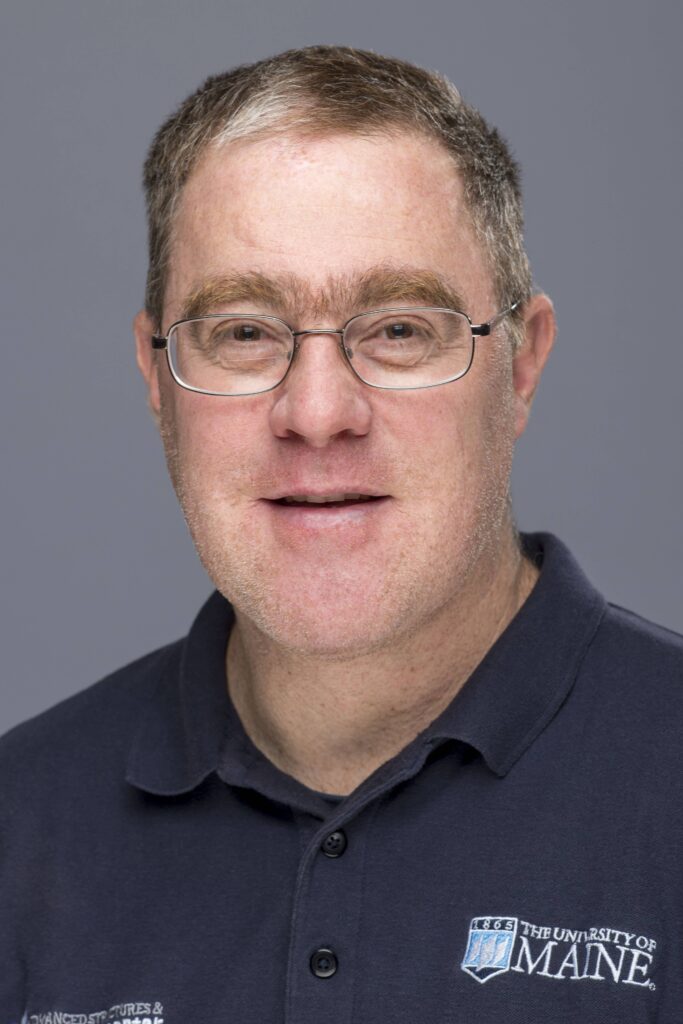Wood Composites Pilot Line
Our complete Wood Composites Pilot Line allows the production of up to 4’ x 8’ oriented strand board (OSB), laminated veneer lumber (LVL), particleboard, Wood Fiber Insulation, and other cellulosic composites on a near-industrial scale.
The Pilot Line
Companies may opt for complete manufacturing – from log to panel – or select only certain unit operations, such as stranding, drying, and screening. Recent studies include the use of innovative, bio-based, resin systems, wax substitutes, fire retardants, and residuals to produce value-added products.

Russel Edgar
Wood Composites Manager

Log Delivery & Conditioning
Companies may deliver tree length or pre-cut logs with a maximum diameter of 12”. Approximately ten 5’ long x 12” diameter logs can be soaked and/or heated at a time to 150°F.
Stranding & Screening
A Carmanah 12/48 Lab Strander converts logs into strands from 3” to 12” in length for OSB/LSL production.
A 48” ring holds two knives that protrude into the inner face of the ring. Strands are produced by advancing the log through the rotating ring at a specified rate. Projection of the knives in combination with ring speed determines the flake thickness, and width is achieved by selection of the appropriate counter knife angle, and strand length through the use of scoring knives.
Drying
Strands are dried on a Koch Bros. in-line conveyor dryer. The forced-air dryer is 3’ wide x 10’ long, with an additional 4’ of infeed and outfeed. The dryer can evaporate up to 250 lbs. of water per hour, at a maximum temperature of 325°F and a fan capacity of 7,500cfm.
A 5,000 board foot, Nyle dehumidification dry kiln is also available bringing strands to within +/- 1% of the target MC, usually within 24 hours.
Resin Blending
Resin is applied to strands using one of two Coil spinning disk atomizing resin blenders (3’ x 6’ and 5’ x 10’). The blender drum can be rotated up to 20 rpm, and the spinning disk atomizer to 15,000 rpm. Either 30 or 120 lbs, for the small and large blender respectively, of dry strands, can be blended at a time. The resins (normally pMDI or PF) and waxes are sent to the blender by means of a peristaltic pump. Wax emulsions are introduced using an air atomizer.
Pressing
Boards are pressed in one of two presses:
450 ton 34″ x 34″ Dieffenbacher steam injection press: This press system is controlled by a PressMan system. Mats can be pressed with thermal oil (up to 450°F) or steam injection (up to 250 psi steam pressure). Steam injection allows for the pressing of thick strand composites.
4’ x 8’ Erie Mill & Press: 1800 ton hydraulic press (provides 725 psi on a full-sized 52”x100” mat). The press is PLC controlled, with complete data collection for a printout of press scheduling data and graphs. The press can be controlled in either position (to within 0.003”) or pressure control (within 2 psi). Energy is provided either by hot oil (up to 500°F) heated platens or radiofrequency (10 kV, 30 kW Thermex-Thermatron system).
Conditioning & Testing
Boards/panels are conditioned prior to testing in a walk-in environmental chamber.
The UMaine Composites Center, an ISO 17025 accredited testing laboratory and has a full suite of ASTM wood products testing capabilities within its accreditation scope (such as ASTM D143, D198, D1037, D4761, etc.). A full list is available here.
